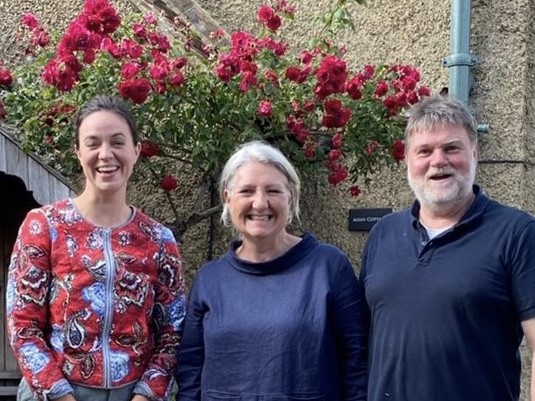
During their talk, Robert and Tracey shared their experience of helping transform the gardens, located just behind Eastbridge Hospital on Canterbury’s High Street, from a rather dull and dilapidated site to the treasure it is today.
The couple commenced their presentation by stating “it all started with murder in the Cathedral”!
Delivering the presentation in turns, they recounted how, in 1224, St Francis of Assisi dispatched nine friars from his Italian order to England. Although originally bound for Oxford, several of the monks opted to remain in Canterbury after seeing the poverty and illness that was associated with many of the city’s pilgrims.
Initially settling on somewhat marshy land, over the next 300 years or so the friars managed to develop a cultivated and thriving priory at the Greyfriar’s site.
However, in 1538, the situation abruptly changed when Henry VIII ascended to the throne and clashed with the Pope and Catholicism. The Priory was disbanded, and the land passed into royal ownership before eventually being granted to a local family. (The sole surviving structure today is the former dormitory – Greyfriar’s Chapel – which was consecrated later in the 1960s.)
Bringing the narrative into more contemporary times, we learned that the site had previously housed a commercial nursery operated by the Smith family until its acquisition by the Eastbridge Hospital Trustees in the 1980s. Since that acquisition, the site has undergone significant transformations and clearances, including several architectural surveys – notably one conducted by the BBC’s Time Team.
In 2001, heralding a substantial transformation, garden designer Sarah Morgan was commissioned to devise a plan for a new garden that harked back to its medieval origins.
Robert and Tracey’s involvement started through a chance encounter with a Herne Bay Rotarian interested in purchasing eggs laid by their chickens. Aware of Robert’s gardening business, he informed them of an impending vacancy at the Hospital due to the retirement of the then gardener. So the couple met with the Trustees and, as Robert happily remarked, “the rest is history!”
Their hands-on involvement with the garden began in March 2020, just a week before lockdown, with Tracy resigning from her teaching position to join Robert. While much of the landscaping for the garden’s had been completed by then, the formidable task of planting, as per the detailed illustrated plan drafted by the designer, remained.
Fortunately, lockdown presented an opportunity for the couple. With the gardens temporarily closed to the public, they were able to focus on digging and planting without distraction. “That was challenging work,” they admitted, “but we thoroughly enjoyed it!”
In the first week alone, the couple received approximately 600 bare-root hedging plants (“literally sticks”) for planting. Their next challenge was to maintain these during the ensuing long, dry, spring and summer months. At the same time, numerous overgrown shrubs had to be removed, and other plants relocated. Additionally, they had the “minor” task of maintaining the two rivers (the Little Stour and the Great Stour)!
The couple’s efforts have since borne fruit. We saw pictures of flourishing wisterias, roses, and a wildflower meadow. They were amused to tell us that their work is often supervised by about six resident robins (one named Bert); they also told us of the presence of other birdlife, including swans and a cormorant.
Notable planting initiatives have included a snowdrop walk (comprising around 2000 bulbs) and a rather amazing “Cutting Garden,” inspired by the friars’ original medieval garden.
Practical considerations have been paramount for the couple. They successfully established a sizable composting area, making the garden self-sufficient in mulch production. Until recently, however, the gardens, spanning approximately 2 acres, posed a significant watering challenge, with watering cans needing to be manually filled from the river using ropes. Fortunately, just this week they acquired a pump and secured a license allowing them to draw water directly from the river.
Following the onset of the pandemic, the gardens transitioned to a paid access model to cover the costs of extensive renovation and maintenance not covered by grants. Nonetheless, the couple operates on a tight budget, cultivating nearly everything from seed. Since spring 2021, they’ve been actively engaged in propagation, showing us images of their efforts on windowsills at home and in their home plant nursery.
The summer of 2021 witnessed abundant growth. An information chalk board was installed in the garden, detailing various plant types and their historical uses. By summer’s end, the couple were busy harvesting seeds in preparation for the following year.
During the talk Robert recounted an amusing anecdote of “finding St Francis” one day while clearing the river beneath Assisi Bridge. Although the statue turned out to be made of resin, they decided to keep it. Initially uncertain of its best placement, St Francis embarked on a “tour” of the garden before ultimately settling on a site in the centre of the Cloister Garth. (Subsequently, the couple learned that the statue had been a fixture of Canterbury’s river tours, prompting the provision of a replacement St Francis for tour participants!)
Robert and Tracey brought their narrative up to the previous summer with beautiful images of the garden. They told us about “companion planting,” remarking on the monks’ expertise in this practice. For instance, to combat insects and diseases like black spot, the monks would plant salvia alongside roses. The couple also reflected on their “crash course” in herbology and medieval plant varieties while establishing the cutting garden. Noteworthy is a bed devoted to plants used in dyeing fabrics (“Dyers bed”), featuring woad, alkanet, madder, and other plants.
The historical uses of certain plants proved intriguing to us. For instance, hissop, akin to lavender, was employed to purify the air and aid in illness recovery. Marjoram featured in winding cloths (used to wrap bodies), while fennel served to settle stomachs and alleviate nausea; it was also enjoyed as a soothing beverage. Tansy acted as a natural insect repellent, and larkspur, the wild precursor to delphiniums, was prized for its vibrant blue flowers, crushed in medieval times to produce blue ink. Yarrow was used to flavour ale (before the use of hops), and water figwort functioned as a poultice to staunch wounds and promote healing.
The Franciscan Gardens featured on BBC’s Gardener’s World in the summer of 2022 (and shown last October – in episode 31) and we were shown a photograph of the couple alongside presenter Francis Tophill.
A slideshow showcased recent images of the garden, including a captivating shot of a Rosa Mundi and Canterbury Bells (formerly known as “Coventry” bells). A picture of the couple mowing the Meadow highlighted the significant effort involved: around 10 days of hard graft. This was followed by an picture of Robert reclining by a shed, captioned “not such a bad way to earn a living”!
Fundraising for restoration projects remains a significant challenge for the Gardens. The estimated cost to restore a large, Victorian vinery is approximately £80,000.
Currently closed for repairs, the gardeners anticipate reopening the gardens this June, and invited eager visitors to experience the garden’s beauty first hand later this summer.
The presentation concluded with an engaging Q&A session, underscoring community interest and support for their endeavours.
To learn more about the gardens click here.
To contact the site supervisor contact supervisor@franciscangardens.org.uk
Picture: Tracey (centre) and Robert (right) pictured with Gardener’s World presenter Francis Tophill. Picture credit: Franciscan Gardens, Canterbury (reproduced with permission).


